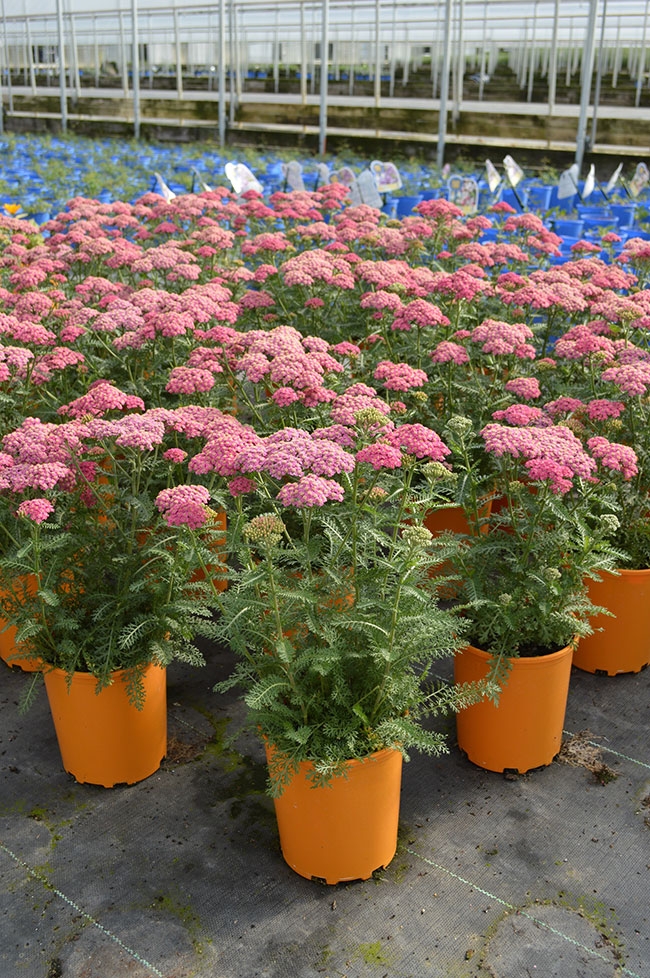
Features
Crops
Flowers
Trends in One of the Fastest Growing Market Segments
Consumers are enthusiastic about what they are finding in the perennial world, and it’s easy to see why.
November 1, 2017 By Karl Batschke
 Achillea is great for fall sales. PHOTOS COURTESY KARL BATSCHKE/DARWIN PERENNIALS
Achillea is great for fall sales. PHOTOS COURTESY KARL BATSCHKE/DARWIN PERENNIALSNovember 2017 – It’s difficult to think of a more diverse, interesting and misunderstood category of plants in the horticultural industry than perennials. A colleague once said that “all plants are annuals somewhere and perennials somewhere else.” Although she oversimplified this just a bit, the point was well taken.
How we define a perennial is often as complicated as the class itself. Geographical conditions as diverse as those experienced in Canada further challenge the definition of perennial plants. Are winters wet and temperate? Some hardy perennials may be perfectly fine in much colder environments and succumb to crown rot in coastal climates. Does winter provide an extended blanket of insulating snow cover? Perennials that may not survive windswept plains will thrive under similar temperatures when protected under the snow.
The good news for flower growers and retailers is that consumers are enthusiastic about what they are finding in the perennial world and the trends and options available are sure to continue to grow this interest in years to come.
IMPRESSIVE NEW BREEDING PROGRAMS
The evolution of perennials during my 40-plus years in the industry has been exciting to watch. The product class has grown from an eclectic mix of varieties and species found and collected by avid hobbyists and observant horticulturists to hundreds of new cultivars, many of them the product of focused, feature-oriented professional breeding programs.
In most cases, the goal is to have perennials that perform like annuals. This is the most common theme that I hear when speaking with consumers and read in consumer surveys on the subject. They tell us that they want plants that flower all season (like annuals) and those that they will not have to re-plant every year.
Fortunately, the vast genetic pool of perennial plants offers the professional flower breeder plenty of options to accomplish this objective. Recent introductions in coreopsis, salvia nemorosa, Salvia greggii, echinacea, gaillardia, achillea and many others provide three or more months of flowering. Many continue to flower after annuals have succumbed to autumn frosts.
PERENNIALS FOR THE DESIGNER
Another wonderful trend in the perennial world is the use of hardy plants in containers. The urbanization of North America and return-to-the-city trend of the millennial generation has created a desire for more plants that perform well in containers. This makes perfect sense because urban living spaces often don’t provide an opportunity for in-ground gardening. The incredible diversity found in the perennial plant world offers a rich and robust palette of colours and textures from which to choose.
In addition to colours and textures, perennial plants provide greater drought and frost tolerance. Gardeners have expressed frustration when their return home from an extended holiday weekend reveals dead and dying container plants that couldn’t survive three or four days without watering. Perennials like hosta, heuchera and ornamental grasses are ideal for these kinds of conditions and will look happy and healthy despite the neglect.
Of course, not all gardeners are concerned about drought or frost tolerance. For them, the expanded design opportunities afforded by perennial plants provide the attraction. The simple addition of white gaura to an annual mixed container not only provides a focal centrepiece, but it also makes the container a pollinator magnet attracting bees and butterflies. In mixed containers, perennial plants provide height, texture, and novelty not found in the annual world.
I love to see attractive perennial foliage plants such as lysimachia ‘Goldi’ or lamium used as lush trailing points of interest. They are as tough as they are attractive and play nicely with their annual cousins.
PERENNIALS FOR THE DECORATOR
The use of perennial plants on the porch, patio and balcony to provide season-long interest is not the only area where this product group is finding new uses. Today’s advances in perennial breeding have brought us cultivars that can be scheduled and programmed to sell alongside decorator plants such as fall mums.
In many regions of North America, the fall season is second only to Christmas in dollars spent on decorating. Capitalizing on this trend, a large grower in the eastern U.S. has found that products like coreopsis UpTick and achillea New Vintage can be easily flowered to help extend the summer season and add sales opportunities for late summer programs. He astutely grew the plants in attractive coloured pots to convey the message that they are intended to for decorative vignettes rather than planted into the ground – just like garden mums. Sales have been excellent, and his customers are happy.
Creative growers and retailers need not limit this opportunity to the fall season, however. Why not accent a summer wedding with brightly decorated pots of echinacea or a spring graduation event with salvia or leucanthemum? Perennials can be timed and scheduled for just these kinds of applications.
IN SUMMARY
Modern perennials are not your father’s Oldsmobile. They have been bred and selected to provide interest in a myriad of settings, are easily scheduled and programmed, and are piquing the interest of consumers. Look for your niche in this expanding category and make the most of the opportunities perennials offer.
Karl Batschke was raised in a greenhouse family in Michigan and has worked in the horticultural industry for over 40 years. He is currently global product development manager for Darwin Perennials. kbatschke@ballhort.com
Print this page



